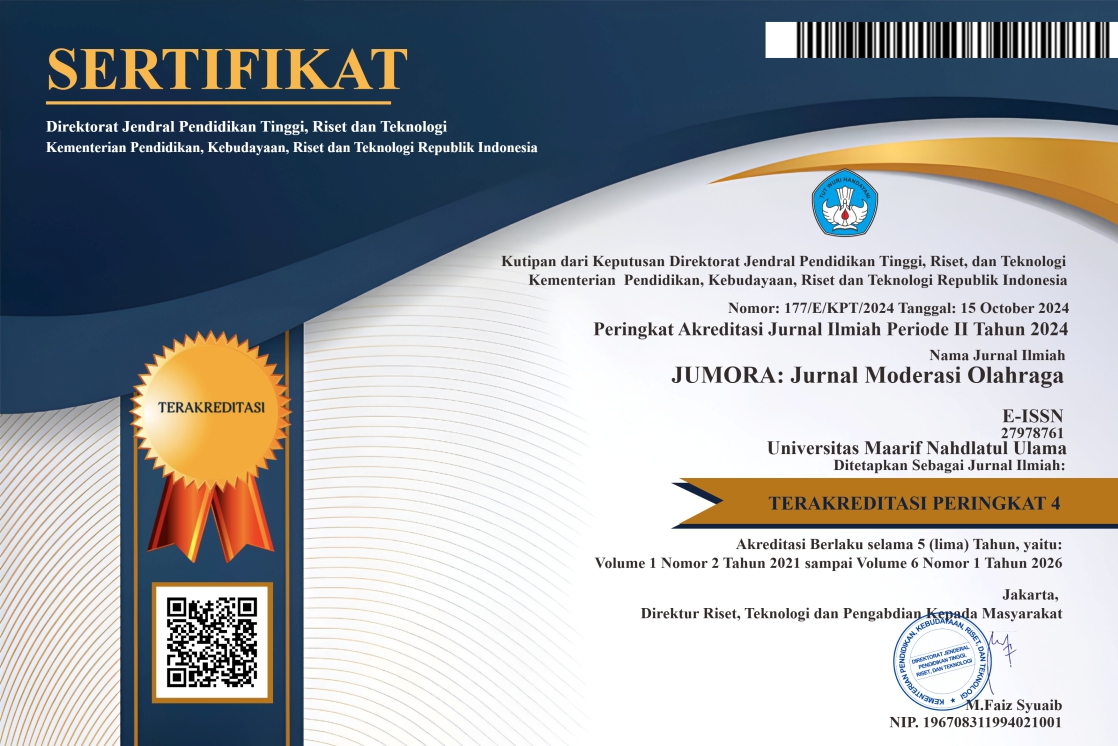The Influence of Play Activities, Nutritional Status and Motor Ability on The Physical Fitness of Primary School Students
DOI:
https://doi.org/10.53863/mor.v4i1.1118Keywords:
Play Activities, Nutritional Status, Motor Ability, Physical FitnessAbstract
This research aims to reveal the influence of playing activities, nutritional status and motor skills on physical fitness. This research method is quantitative using a path analysis approach. The population of this study was all students at SD N 14 Jati Tanah Tinggi, Padang City, totaling 163 people. The sampling technique was carried out by purposive sampling, with a total sample of 49 people. Data was collected by filling out questionnaires for playing activities, measuring body weight and height for nutritional status, throwing a basketball, running for four seconds, passing a ball against a wall and jumping without a start to measure motor skills, and to measure students' physical fitness, the TKJI test was used to elementary school age children. The results of research and data analysis show that: (1) Playing activities have a direct and significant effect on physical fitness by 12.6% (2) Nutritional status has a direct and significant effect on physical fitness by 12.4% ( 3) Motor Ability has a direct and significant effect on physical fitness by 9.2% (4) Playing activities have an indirect effect on Physical Fitness through Motor Ability by 17.7% (5) Nutritional status has an indirect effect on Physical Fitness through Motor Ability is 28.1% (6) Playing Activities, Nutritional Status and Motor Ability simultaneously influence students' Physical Fitness by 48.2%
References
Adiska, F. F. D., Heynoek, F. P., Fathoni, A. F., & Nurrochmah, S. (2024). Survei Status Gizi dan Keterampilan Motorik Pada Peserta Didik Sekolah Dasar Kelas Bawah. Sriwijaya Journal of Sport, 3(2), 123–138.
Ariestika, E., Widiyanto, & Agung Nanda, F. (2021). Implementasi Standar Pedoman Nasional Terhadap Tujuan Pendidikan Jasmani. Sains Olahraga Dan Pendidikan JasmaniI, 21, 1–10. http://sportscience.ppj.unp.ac.id/index.php/jss/article/download/58/64
Ateljevic, D., & Nanda, F. A. (2023). The impact of structured regular physical activity on the development of individual motor skills in school-aged children. JUMORA: Jurnal Moderasi Olahraga, 3(2), 178–189. https://doi.org/10.53863/mor.v3i2.883
Barlian, E. (2016). Metode Penelitian Kualitatif dan Kuantitatif. Penerbit Sukabina Press.
Burhaein, E., & Solekhah, N. (2023). Tingkat kebugaran jasmani pasca pandemi covid-19: kondisi terkini pada siswa sekolah dasar. Journal of S.P.O.R.T.
Deevona, N. W., Syampurma, H., Umar, A., & Edwarsyah, E. (2023). Hubungan Status Gizi Dengan Hasil Belajar Siswa Sekolah Dasar Negeri 006 Pangkalan Kerinci Kabupaten Pelalawan. Jurnal JPDO, 6(4), 47–53. http://jpdo.ppj.unp.ac.id/index.php/jpdo/article/view/1318
Fadlan, A. R., Wahyuri, A. S., Ihsan, N., Komaini, A., & Batubara, R. (2023). Pengembangan E-Modul Pembelajaran Pendidikan Jasmani Olahraga Dan Kesehatan (PJOK) Materi Kebugaran Jasmani Kelas IV Sekolah Dasar Berbasis Aktivitas Bermain. Wahana Didaktika?: Jurnal Ilmu Kependidikan, 21(1), 73–84. https://doi.org/10.31851/wahanadidaktika.v21i1.10993
Jariono, G., Nurhidayat, N., Sudarmanto, E., & Indarto, P. (2024). Can elementary school students ’ physical fitness be improved using circuit training?? The 19th University Research Colloqium, 1–11.
Natal, Y. R., Wani, B., Mau, F. N., & Fole, F. R. (2023). Pendampingan Pembelajaran Penjas Menyenangkan Melalui Permainan Tradisional Sagu Alu Di Sd Citra Bakti. Jurnal Media Abdimas, 2(3), 70–75.
Nopiyanto, Y. E., Insanistyo, B., Raibowo, S., Prabowo, A., Andriyani, M., & Ibrahim, I. (2023). Analisis tingkat kepercayaan diri siswa pada pembelajaran Penjas di SD Negeri 82 Bengkulu Tengah. Jurnal Patriot, 5(3), 165–173. https://doi.org/10.24036/patriot.v5i3.962
Pamungkas, G. N. P., Sukarmin, Y., & Nanda, F. A. (2022). Evaluation of the implementation of the adaptive physical education curriculum. Advances in Health and Exercise, 2, 29–37.
Pomatahu, A. R., Nofrizal, D., Agustin, T., Pauweni, M., Gorontalo, N., Bina, U., & Palembang, D. (2023). Pendampingan Pengukuran Dan Penilaian Status Gizi. JURNAL ABDIMAS PATIKALA, 3(2), 876–881.
Prasetiyo, R., Synthiawati, N. N., & Susanto, N. (2023). Pengembangan Model Pembelajaran Outdoor Games Activities untuk Meningkatkan Problem Solving Skills Siswa. Jurnal Obsesi?: Jurnal Pendidikan Anak Usia Dini, 7(6), 7362–7370. https://doi.org/10.31004/obsesi.v7i6.5545
Prodyanatasari, A. (2024). Meningkatkan Kemampuan Motorik Kasar Melalui Senam Ceria (Improving Gross Motor Skills Through Cheerful Gymnastics). Media Abdimas, 4(1), 10–16. https://doi.org/10.37817/mediaabdimas.v4i1.3607
Safitri, R. E., Safari, I., & Supriyadi, T. (2023). Peningkatan Kemampuan Motorik Kasar Lari Melalui Permainan Tradisional Kucing Jongkok Improving Gross Motor Ability Run Through Traditional Cat Squating Game. Jambura Health and Sport Journal, 5(1), 74–84.
Saputra, A., Akhbar, M. T., & Candra, J. (2023). Survei Tingkat Kesegaran Jasmani Siswa yang Mengikuti Ekstrakurikuler Olahraga Sepak Bola. Jurnal Prestasi, 7(1), 1. https://doi.org/10.24114/jp.v7i1.47385
Sari, D. N. (2024). Kebugaran Jasmani Siswa Sekolah Dasar. Jurnal Pendidikan Dan Olahraga, 5(2), 133–138. https://doi.org/10.24036/sporta.v5i2.149
Suryadi, D. (2022). Analisis kebugaran jasmani siswa: Studi komparatif antara ekstrakurikuler bolabasket dan futsal. Edu Sportivo: Indonesian Journal of Physical Education, 3, 100–110. https://doi.org/10.25299/es:ijope.2022.vol3(2).9280
Syahara. (2011). Pertumbuhan dan Perkembangan Fisik Motorik. Fakultas Ilmu Keolahragaan Universitas Negeri Padang.
Downloads
Published
How to Cite
Issue
Section
License
Copyright (c) 2024 Riwaldi Putra,Deri Putra,Fitri Agung Nanda

This work is licensed under a Creative Commons Attribution-ShareAlike 4.0 International License.
Authors retain copyright and grant the journal right of first publication with the work simultaneously licensed under a Creative Commons Attribution-ShareAlike 4.0 International License that allows others to share the work with an acknowledgment of the work’s authorship and initial publication in this journal











